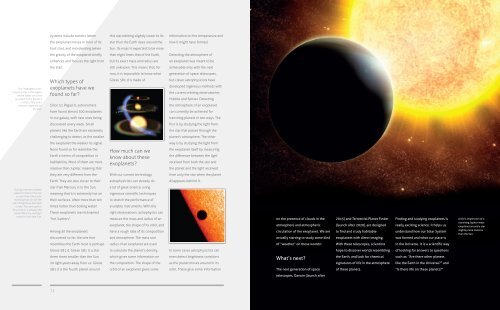Sol Lucet Omnibus - ESO
Sol Lucet Omnibus - ESO
Sol Lucet Omnibus - ESO
- TAGS
- lucet
- omnibus
- www.eso.org
You also want an ePaper? Increase the reach of your titles
YUMPU automatically turns print PDFs into web optimized ePapers that Google loves.
The “habitable zone”<br />
around a star is the region<br />
where water can exist<br />
as a liquid on a planet’s<br />
surface. This exact<br />
distance depends on<br />
the star.<br />
During a transit, a planet<br />
passes in front of its star<br />
as seen from the Earth,<br />
meaning that we see the<br />
star’s brightness decrease<br />
a little. The dark spot in<br />
this picture is actually the<br />
planet Mercury, during a<br />
transit of our own Sun.<br />
systems include transits (when<br />
the exoplanet moves in front of its<br />
host star), and microlensing (when<br />
the gravity of the exoplanet briefly<br />
enhances and focuses the light from<br />
the star).<br />
Which types of<br />
exoplanets have we<br />
found so far?<br />
Since 51 Pegasi b, astronomers<br />
have found almost 500 exoplanets<br />
in our galaxy, with new ones being<br />
discovered every week. Small<br />
planets like the Earth are extremely<br />
challenging to detect, as the smaller<br />
the exoplanet the weaker its signal.<br />
None found so far resemble the<br />
Earth in terms of composition or<br />
habitability. Most of them are more<br />
massive than Jupiter, meaning that<br />
they are very different from the<br />
Earth. They are also closer to their<br />
star than Mercury is to the Sun,<br />
meaning that it is extremely hot on<br />
their surfaces, often more than ten<br />
times hotter than boiling water!<br />
These exoplanets are nicknamed<br />
“hot Jupiters”.<br />
Among all the exoplanets<br />
discovered so far, the one that<br />
resembles the Earth most is perhaps<br />
Gliese 581 d. Gliese 581 is a star<br />
three times smaller than the Sun,<br />
20 light-years away from us. Gliese<br />
581 d is the fourth planet around<br />
72<br />
this star,orbiting slightly closer to its<br />
star than the Earth does around the<br />
Sun. Its mass is expected to be more<br />
than eight times that of the Earth,<br />
but its exact mass and radius are<br />
still unknown. This means that, for<br />
now, it is impossible to know what<br />
Gliese 581 d is made of.<br />
How much can we<br />
know about these<br />
exoplanets?<br />
With our current technology,<br />
astrophysicists can already do<br />
a lot of great science, using<br />
ingenious scientific techniques<br />
to stretch the performance of<br />
available instruments. With the<br />
right observations, astrophysics can<br />
measure the mass and radius of an<br />
exoplanet, the shape of its orbit, and<br />
have a rough idea of its composition<br />
and atmosphere. The mass and<br />
radius of an exoplanet are used<br />
to calculate the planet’s density,<br />
which gives some information on<br />
the composition. The shape of the<br />
orbit of an exoplanet gives some<br />
information on the temperature and<br />
how it might have formed.<br />
Detecting the atmosphere of<br />
an exoplanet was meant to be<br />
achievable only with the next<br />
generation of space telescopes,<br />
but clever astrophysicists have<br />
developed ingenious methods with<br />
the current orbiting observatories<br />
Hubble and Spitzer. Detecting<br />
the atmosphere of an exoplanet<br />
can currently be achieved for<br />
transiting planets in two ways. The<br />
first is by studying the light from<br />
the star that passes through the<br />
planet’s atmosphere. The other<br />
way is by studying the light from<br />
the exoplanet itself by measuring<br />
the difference between the light<br />
received from both the star and<br />
the planet and the light received<br />
from only the star when the planet<br />
disappears behind it.<br />
In some cases astrophysicists can<br />
even detect brightness variations<br />
as the planet moves around in its<br />
orbit. These give some information<br />
on the presence of clouds in the<br />
atmosphere and atmospheric<br />
circulation of the exoplanet. We are<br />
actually starting to study some kind<br />
of “weather” on these worlds!<br />
What’s next?<br />
The next generation of space<br />
telescopes, Darwin (launch after<br />
2015) and Terrestrial Planet Finder<br />
(launch after 2020), are designed<br />
to find and study habitable<br />
exoplanets with direct imaging.<br />
With these telescopes, scientists<br />
hope to discover worlds resembling<br />
the Earth, and look for chemical<br />
signatures of life in the atmosphere<br />
of these planets.<br />
Finding and studying exoplanets is<br />
really exciting science. It helps us<br />
understand how our <strong>Sol</strong>ar System<br />
was formed and what our place is<br />
in the Universe. It is a scientific way<br />
of looking for answers to questions<br />
such as: “Are there other planets<br />
like the Earth in the Universe?” and<br />
“Is there life on these planets?”<br />
73<br />
Artist’s impression of a<br />
transiting Jupiter-mass<br />
exoplanet around a star<br />
slightly more massive<br />
than the Sun.

















